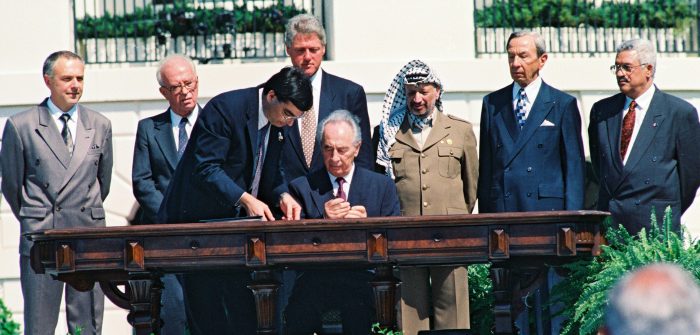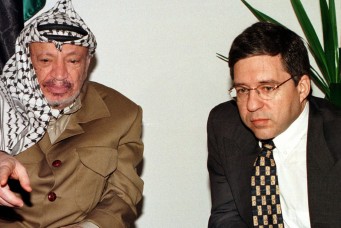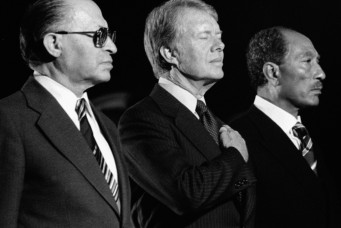Developing the Concept of Palestinian Autonomy
How the Camp David Accords, as well as a little-known series of negotiations called the “Autonomy Talks,” came to serve as the basis for Palestinian self-rule during the Oslo negotiations

Lawyer Joel Singer stands left of then-Israeli Foreign Minister Shimon Peres while he signs the historic Oslo I Accord at the White House, Sept.13, 1993. Avi Ohayon/GPO
People tend to think that Israelis and Palestinians are incapable of negotiating. However, this is not at all correct. In fact, the two parties spent years talking and negotiating, reaching agreements, and coming up with plans that perhaps, one day, will form the basis for a real peace in their region. The greatest evidence of their diplomatic engagement has been the 1993 Oslo Agreement.
The autonomy, or self-government, arrangements contained in the Oslo Agreement are based on “A Framework for Peace in the Middle East,” a part of the 1978 Camp David Accords, which in turn are based on the self-rule plan for the Palestinians of the West Bank and Gaza (WBG), developed by Israeli Prime Minister Menachem Begin in late 1977.
From its inception, the autonomy idea and its various detailed implementing models have been criticized widely by Palestinians and Israelis, as well as numerous third parties, as inadequate even as a temporary solution for what the Camp David Accords referred to as the “Palestinian problem.” Yet, notwithstanding all of its shortcomings, forty years after the Camp David Accords were signed and twenty-five years after the Oslo Agreement was executed, the autonomy arrangements still hold. Paraphrasing Winston Churchill’s famous remarks about democracy, one may conclude that, at least for now, until the time is ripe for entering into a permanent status agreement, autonomy “is the worst form of government except all other forms that have been tried from time to time.”
Begin’s autonomy idea evolved over time, through several rounds or iterations, until it was incorporated, in a modified form, into the Oslo Agreement. Begin intended his autonomy plan to be a vehicle for perpetuating Israel’s control of the WBG. By the time the Oslo negotiations commenced, the idea of Palestinian autonomy (or interim self-government) had already been accepted widely, including in the Camp David Accords and in the Letter of Invitation to the Middle East Peace Conference that was convened in Madrid in 1991. In formulating its positions regarding the accords, therefore, the government of Israeli Prime Minister Yitzhak Rabin and Foreign Minister Shimon Peres also accepted the autonomy concept. Rabin and Peres, however, altered this concept significantly so as to serve a different objective: a route for ultimately creating a Palestinian entity separate from Israel.
Round 1: Begin’s Self-Rule Plan
The autonomy, or self-rule plan for the WBG was first conceived by Begin in response to Egyptian President Anwar Sadat’s historic visit to Jerusalem that began on November 19, 1977. In his speech to the Knesset, Sadat offered Israel complete peace in return for full Israeli withdrawal from the Israeli-occupied Sinai, but also demanded that Israel recognize the right of the WBG Palestinians to self-determination, including the right to establish their own state.
While Begin accepted Sadat’s condition of full withdrawal from the Sinai Peninsula, he also developed a counter-proposal regarding the WBG Palestinians, which he discussed with President Jimmy Carter in Washington D.C. on December 16, 1977; with Sadat in Ismailia, Egypt, on December 25, 1977; and then presented to the Knesset on December 28, 1977. Begin’s Plan—a 26-point document called “Self-rule for Palestinian Arabs, Residents of Judea, Samaria and the Gaza District, Which Will Be Implemented Upon the Establishment of Peace”—was intended to represent a permanent solution to the Palestinian problem through establishing self-rule arrangements for the Palestinians residing in the WBG that Israel would implement. The plan’s leitmotif was that it provided for personal, rather than territorial, autonomy. Stated otherwise, the elected Palestinian government would have authority only over the administrative affairs of the WBG Palestinians, but not over the land.
This plan included the following main elements: that administrative autonomy would be established in the WBG for its Palestinian inhabitants; that Palestinian inhabitants of the WBG would elect an eleven-member administrative council that would control eleven administrative departments covering all civilian (that is, non-security related) governmental functions. The plan went on to state that the Israeli military government would be abolished but security and public order would be maintained by Israel through Israeli forces that would remain deployed throughout the WBG. Although the administrative council would, among other things, be in charge of supervising the operations of local police forces, the plan did not explain exactly what authority the Palestinian police would have, given that the main task for maintaining public order would remain with the Israelis.
Moreover, the plan mandated that the administrative counsel be given the authority to promulgate regulations relative to the eleven administrative departments it will operate, but that the power to legislate would be delegated to a joint Palestinian–Israeli–Jordanian committee that would have the mandate of deciding, only unanimously, which laws would remain in place and which would be abolished. The plan allowed Israelis to settle freely in the WBG, but left open the question of sovereignty. Finally, the plan stated generally that its principles would be subject to review after a five-year period. The plan neither specified the method of this review nor stated that the review would involve any parties other than Israel.
I had an opportunity to review Begin’s Plan before it was finalized—that is, when it was submitted for comment to the international law department of the Israeli Defense Forces’ Judge Advocate General Unit, where I then served as a young officer. My immediate reaction was to advise against autonomy as a permanent solution for the Palestinian problem. Autonomy is only potentially appropriate when the inhabitants of an autonomous area constitute a relatively small minority in that country and have some allegiance to the central government, based on either common ethnic, religious, or cultural connections with the country’s majority, but still have some unique characteristics that they desire to express. In such cases, these inhabitants might accept autonomy as a suitable compromise between their secessionist tendencies, if those were not too strong, and their loyalty to the central government.
Israelis, the majority of whom are Israeli Jews, and WBG Palestinians, however, do not share any of these common denominators. They speak different languages, have different ethnicities, different religions, and their cultures and historic backgrounds are separate. Their political and national aspirations are also distinct. Because of that, the WBG Palestinians have no allegiance at all to the Israeli government and want to break from Israel and accomplish their national goals separately. I therefore concluded that, for autonomy to be established in the WBG and hold strong, it must either be almost indistinguishable from the Israeli military occupation, which Egypt, Jordan, and the Palestinians would not accept, or it must be so wide in scope or, at least limited in duration, as to be perceived as similar to an independent Palestinian state (or, at least, inevitably leading to the creation of one), which Begin would never accept. Begin’s autonomy plan doubtlessly intended to maintain full Israeli control over the WBG. It is therefore unsurprising that Egypt rejected it out of hand.
The United States, however, adopted a more nuanced position. On the one hand, it criticized Begin’s Plan for not sufficiently addressing Sadat’s as well the United States’s expectations regarding the resolution of the Palestinian problem. On the other hand, the United States concluded that the plan contained enough elements that could serve as a starting point for negotiations and, if ultimately accepted by the other parties, could serve as a preliminary step that would lead to the creation of a Palestinian state. Therefore, a modified version of Begin’s autonomy plan became the basis for the Camp David negotiations regarding the Palestinian prong of the accords.
Round 2: The Camp David Accords
The Camp David Accords adopted Begin’s basic idea of Palestinian autonomy, which the accords called “self-government,” including the establishment of a Palestinian police and the holding of elections for a Palestinian Council. Nonetheless, instead of making this a permanent solution, the accords treated “autonomy” as a transitional arrangement for five years only, by the end of which the final status of the WBG was to be determined through negotiations among Israel, Egypt, Jordan, and the elected representatives of the Palestinians. These negotiations were to begin no later than the third year of the transitional period.
There were several other important changes made to Begin’s Plan in the Camp David Accords. Namely, Israeli forces would not remain deployed throughout the WBG. Instead, the accords required that a withdrawal of Israeli armed forces would take place, though not a full withdrawal; rather, there would be a redeployment of the remaining Israeli forces into specified security locations. Also, the accords did not indicate, as Begin’s Plan had, that security and public order would remain an Israeli responsibility—instead, they simply stated that the detailed autonomy agreement to be negotiated would include “arrangements for assuring internal and external security and public order.”
Under Begin’s Plan, Israel would alone define the details of autonomy and implement it on its own, whereas the Camp David Accords called for negotiations among Israel, Egypt, and Jordan on “an agreement which will define the powers and responsibilities of the self-governing authority to be exercised in the [WBG].” Importantly, the accords also called for the inclusion of Palestinians in the Egyptian and Jordanian delegations to negotiate the post-accords autonomy arrangements (the “Autonomy Talks”).
Some provisions that appeared in Begin’s Plan were not carried forward to the Camp David Accords. For example, the extensive language in Begin’s Plan emphasizing that the authority of the Palestinian Council would be personal (that is, applying to people only) rather than territorial disappeared in the Camp David Accords, and so did the statements in Begin’s Plan which implied that the elected Palestinian Council would not have legislative authority and would be small—eleven members only. At the same time, the accords did not say the opposite. Rather, they were silent on whether or not the elected Palestinian Council would have the authority to legislate; they did not indicate the size of the council; nor did they spell out the scope of its authority by listing the departments it would manage. Moreover, in one place, the accords referred to the elected council as a “self-governing authority/administrative council,” that is, it confusingly used, side-by-side, the conflicting expressions proposed by the two parties.
The Camp David Accords contained many other ambiguities, likewise reflecting contradictory positions expressed by the parties. This left much to be negotiated to determine the scope of authority and nature of the Palestinian autonomy in the subsequent Autonomy Talks.
Round 3: The Autonomy Talks
Shortly after the Camp David Accords were signed, Jordan declined an invitation to join the Autonomy Talks, which lasted from 1979 to 1982. Further, Egypt was unable to convince any Palestinians to join its delegation, primarily due to public statements made by Yasser Arafat’s Fatah movement, the dominant faction of the Palestine Liberation Organization (PLO). Those statements expressed complete rejection of the accords and called on Palestinians to reject the idea of a self-governing authority in the WBG as well as boycott any elections for such a body. Fatah also warned that anyone who became involved would “pay the price for his betrayal.” As a result, participation in the Autonomy Talks was limited to delegations from Egypt, Israel, and the United States, which now pledged to be a full partner in the talks.
The main purpose of the talks was to develop an agreement that would provide more details to the general principles outlined in the Camp David Accords, and also resolve the many ambiguities within its text. In fact, while the parties managed to reach a detailed agreement on some areas of the non-central issues by the end of the three-year duration of the talks, by and large, the gaps between the parties’ positions remained as wide as they had been at the outset, or perhaps even wider.
In early 1980, the huge gaps between Egyptian and Israeli positions were fully exposed when both countries exchanged documents containing their respective detailed models of autonomy. The Israeli model of autonomy resembled Begin’s pre-Camp David self-rule plan, while the Egyptian type of autonomy was modeled after the structure and authority of a fully independent sovereign state (minus the responsibility for external security and foreign affairs). This should not have come as a surprise. To reach any agreement, one must bridge the gaps between the parties’ positions and, to do so, there must be a lot of “give and take” between the parties. In the Autonomy Talks, the initial gaps were exacerbated. Given the total Palestinian rejection of the Camp David Accords, Egypt was not, and did not feel itself, empowered by the Palestinians to “give” anything, but rather only to “take.” Israel similarly was not prepared to give anything, because, as a tactical matter, it understood that Egypt was not empowered to reciprocate by also giving. Furthermore, politically, the right-wing Israeli Likud government headed by Begin was not prepared to make concessions on many key issues.
Even though an autonomy agreement was not reached at the conclusion of these talks, it is interesting to look at the respective positions of the parties on the key issues, in order to understand how Israel’s positions regarding these key issues changed when, subsequently, the Rabin–Peres government negotiated the Oslo Agreement.
The autonomy’s territorial scope or jurisdiction. Israel’s position was that autonomy would be “personal,” that is, the authority of the Palestinian Council would apply to the inhabitants of the WBG, and not to the territory. Egypt’s position was that the authority of the self-governing authority, or the SGA for short, should cover the WBG territory as well as its inhabitants.
The nature and size of the SGA (administrative council). Israel’s position was that the Palestinian Council would comprise one, small, eleven-member body that would have authority only over administrative matters without legislative authority. Egypt’s position was that the SGA should consist of three branches of government: a large legislative body to be elected by the Palestinians (comprised of at least thirty members), from which a smaller, executive body would be selected, as well as a judicial branch.
Powers and responsibilities of the SGA. Israel’s position was that there was a need to negotiate the scope of the powers and responsibilities delegated by the Israeli military government to the administrative Palestinian Council (some of which would be subject to cooperation or coordination with Israel), with the understanding that powers and responsibilities not delegated would remain under Israel’s domain. Egypt’s position was that all of the authority exercised by the Israeli military government should be assumed by the SGA.
Jerusalem. Israel asserted that Jerusalem is the undivided capital of Israel, and so the autonomy arrangements would not apply there. Egypt’s position was that the annexation of Jerusalem was illegal, and that the city, as part of the West Bank, would be the seat of the SGA, where it would exercise its full powers.
Settlements. Israel’s position was that Israelis would have the right to settle freely in the WBG and that the settlements would not be subject to the authority of the administrative Palestinian Council. Egypt took the position that the settlements were illegal and should be withdrawn at the end of the transitional period, that a ban would be imposed on new Israeli settlements and on the expansion of existing ones and that, during the transitional period, all Israeli settlers would be subject to the authority of the SGA.
Elections. Israel and Egypt managed to reach significant agreement regarding the detailed modalities of the Palestinian elections, but one major disagreement remained: Egypt’s position was that the Palestinians of East Jerusalem would be able to freely participate in the elections, by being allowed to both vote and be elected to the SGA. Israel’s position was that Palestinians of East Jerusalem would not be allowed to participate in the elections in any capacity.
Security. Israel’s position was that it would hold responsibility for both external and internal security (that is, the fight against terrorism), while the administrative Palestinian Council’s police would be responsible for public order under Israel’s ultimate supervision. Egypt’s argument was that, while Israel would have control of external security, the SGA would be responsible for both public order and internal security. Moreover, the remaining Israeli forces in the WBG would be confined to “specified security locations” and would not be able to move into or through the WBG without Palestinian permission.
In internal Israeli consultations, several participants, including the present author, proposed occasionally, due to practical considerations, to modify the Israeli approach to some of the disputed issues. For instance, suggestions were made that the Palestinian Council gain legislative authority and for its size to be increased significantly. However, Begin rejected these ideas, preferring to avoid making any indication that the Palestinian Council had any attributes of statehood over pragmatic considerations. After three years of autonomy discussions, the only concession made by Israel was the agreement to increase the size of the administrative Palestinian Council from eleven to thirteen members.
Round 4: The Oslo Agreement
A major shift in the course of the autonomy discussions occurred as a result of an exchange of letters between Israel and the PLO dated September 9-10, 1993, known as the Mutual Recognition Agreement. The Israeli letter contained Israel’s recognition of the PLO as the representative of the Palestinian people and an agreement to negotiate with the PLO within the Middle East peace process. From this point on, many, but not all, of the formal roles assigned to Jordan and Egypt in previous rounds were obviated. Instead, these countries, and particularly Egypt, began to play an indispensable, practical role in helping Israel and the PLO bridge gaps between their positions and resolve disputes about the implementation of the Oslo Agreement.
Most of the issues that were the subject of extensive negotiations, and sharp disagreements, between Israel, Egypt, and the United States in prior rounds continued to be important in the Israel–PLO negotiations over the Oslo Agreement. However, there was a quantum leap in Israel’s approach to the autonomy arrangements (and, implicitly, to the ultimate resolution of the Palestinian problem) from that of Begin to that of the Rabin–Peres government.
Rabin and Peres asked me, in early June 1993, to help fix the draft of the Declaration of Principles on Self-Government Arrangements (DOP), that had been secretly developed in Oslo by two Israeli academics, Prof. Yair Hirschfeld and Dr. Ron Pundak, and PLO representatives. They chose me primarily because they knew that I had a central role, as a non-political expert, in previous rounds of the autonomy discussions.
The DOP was a short agreement that contained only a list of agreed principles to be fleshed out in negotiations of detailed implementing agreements, which would later come to be labeled as the Gaza–Jericho (or Cairo) Agreement and the Interim Agreement. Both the DOP and its implementing agreements generally built on the Camp David Accords and the Autonomy Talks. When negotiating the draft DOP in Oslo and, subsequently, all of its implementing agreements, I drew heavily upon formulations previously created in the Camp David Accords and by the parties to the Autonomy Talks, in which I played a key role. In other words, I used Israeli positions, Egyptian positions, and American bridging ideas, as well as new concepts that I developed, as building blocks to create solutions for the various issues in dispute, all under the political instruction of Rabin and Peres.
On the first issue—the autonomy’s territorial scope—in principle, the Palestinian Council had jurisdiction over the entire territory of the WBG, except for the areas of settlements and specified Israeli military locations. As such, the council’s jurisdiction was territorial, as Egypt demanded in the Autonomy Talks, not personal, as in Begin’s Plan. However, in practice, the council’s jurisdiction was to be expanded gradually in four phases: first, in Gaza and Jericho; second, in seven large Palestinian towns in the West Bank; and finally, through two additional Israeli redeployments in additional areas of the West Bank, the scope of which was left for Israel to determine. As such, the Oslo Agreement’s approach to the jurisdiction issue actually represented a compromise between the Egyptian and Israeli positions. It applied Palestinian jurisdiction to areas populated by Palestinians, but also to the territory where they resided.
On the second issue regarding the nature and size of the administrative Palestinian Council or the SGA, the Egyptian position was adopted almost completely. The structure of the Palestinian authority included three bodies: a large legislative body or the elected Palestinian Council, consisting of eighty-two members, an executive body selected from among the members of the council, and a judicial body. As such, it entirely discarded the approach of Begin’s Plan, which would have limited the Palestinian Council to an administrative role.
With regards to the powers and responsibilities of the SGA—the third issue— formally, Israel’s position was adopted in that the Interim Agreement addressed in a detailed manner what functions of the former Israeli civil administration were to be transferred to Palestinian hands. In reality, however, almost all of these functions, covering forty separate spheres of civil authority, were transferred, including all authority related to land in the areas from which Israeli forces withdrew. Israel retained only the authority to administrate security and foreign affairs. However, some of the powers transferred to the Palestinians were subject to coordination and cooperation with Israel.
For the fourth and fifth points, Israel’s positions were adopted. Jerusalem was not placed under the jurisdiction of the Palestinian authority, and neither were Jewish settlements. Similarly, no limitation on establishing new Israeli settlements or expanding existing ones were included in the Oslo Agreement.
Sixth, on the Palestinian elections, a compromise arrangement was reached that adopted a part of Israel’s position and a part of Egypt’s position. Consistent with Egypt’s position, Palestinian residents of East Jerusalem were allowed to participate in elections by voting. However, following Israel’s position, to be a candidate in the Palestinian elections, one had to have residency in areas under Palestinian jurisdiction and, thus, East Jerusalem residents could not run for elections.
And finally, as for internal security, as discussed earlier, in previous rounds, the parties agreed that Israel would be responsible for external security and the SGA would be responsible for public order. However, no agreement had ever been reached regarding who would be responsible for internal security, with Egypt arguing it should be the Palestinians and Israel arguing it should remain with the Israelis. In Oslo, Rabin instructed me to propose the following formula, which the PLO accepted, and was included in the DOP: the Palestinians would be responsible for public order and internal security of Palestinians, and Israel would continue to be responsible for defending itself against external threats and for internal security of Israelis. In other words, Rabin envisioned a situation in which Israel and the PLO would share the responsibility for internal security, rather than Israel alone being responsible for it. Subsequently, this principle was implemented in great detail in Annex I to the Interim Agreement (Protocol Concerning Redeployment and Security Arrangements). This protocol also contained numerous arrangements for coordination and cooperation between Israeli and Palestinian forces. However, an overriding agreed principle remained: once the Israeli forces withdrew from an area and handed it over to the Palestinians, Israeli forces would not re-enter that area, with the exception of situations involving hot pursuit of terrorists.
Moreover, the Rabin–Peres government agreed in Oslo to allow the PLO to relocate from Tunisia to the WBG, accompanied by a large Palestinian armed force (called “Police” in the Oslo language) in order for it to be responsible, side-by-side with Israel, for maintaining internal security for Palestinians. More than anything else in the Oslo Agreement, this demonstrates that, unlike Begin, who fifteen years earlier constructed the autonomy idea as a permanent solution for the WBG, the Rabin–Peres government genuinely intended the Oslo version of autonomy to be a transitory arrangement that would ultimately lead to the creation of a separate Palestinian political entity.
Unwasted Efforts
The Oslo Agreement does not reference the Camp David Accords as its foundation. However, both the Palestinian and Israeli delegations kept copies of the accords in Oslo and consulted them repeatedly during the peace talks. As indicated above, I also carried three years’ worth of formulations from the Autonomy Talks, which I used extensively in drafting the final Oslo Agreement and, subsequently, its implementing agreements.
Likewise, when a peace agreement is to be finally signed between Israelis and Palestinians, it is unlikely to reference the Oslo Agreement as its basis. Even though both the Camp David Accords and the Oslo Agreement are now considered failures for not immediately leading to a permanent agreement, I am confident that the solutions found in the Oslo Agreement, as well as the formulations developed by the parties in their many years of negotiations following Oslo, will again serve as building blocks whenever the time comes for a peace agreement to be finally reached. The efforts made in Camp David and Oslo therefore have not been wasted.
Joel Singer is former legal advisor to the Israeli Foreign Ministry under the Rabin–Peres government. He negotiated the Israel–PLO Mutual Recognition Agreement as well as the Oslo Agreement and its implementing agreements with the PLO from 1993 to 1996. Singer was also a principal author of the Israeli autonomy model developed under the 1978 Camp David Accords and was a member of the Israeli delegation to the “Autonomy Talks” held from 1979 to 1982.
Subscribe to Our Newsletter





